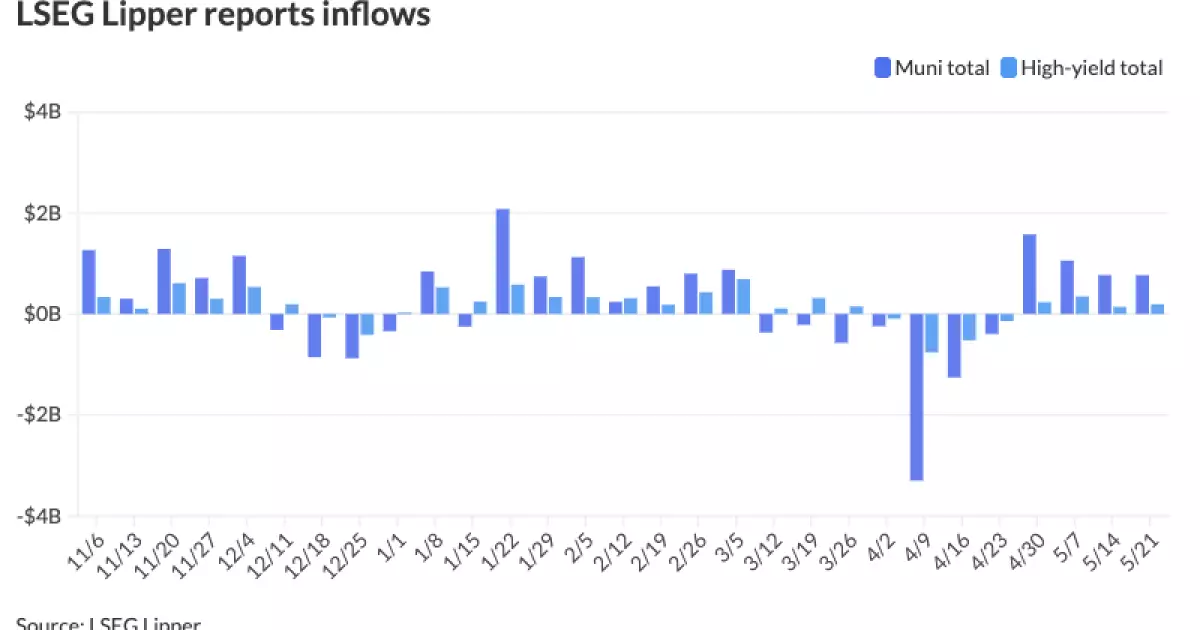The municipal bond market is the silent engine of U.S. infrastructure, funding essential services like education and transportation. Yet, recent trends suggest that this seemingly stable market is teetering on the brink of instability. With U.S. Treasury yields fluctuating, there is an eerie undercurrent of volatility that has investors on edge. The challenge, as we see, isn’t merely the shifting numbers but the underlying concerns about fiscal irresponsibility and the inevitable implications on the economy.
Ratios and Yield: A Flashing Warning Sign
The municipal-to-U.S. Treasury (muni-UST) ratios stand at troubling figures: a 72% ratio for two-year bonds, stagnating at similar levels through the five-year and ten-year offerings, and ominously high at 90% for thirty-year bonds. When such ratios exist, they reflect an unhealthy alignment with how investors perceive risk versus return. These indicators are symptomatic of a deeper malaise within municipal finance. What they reveal is not merely a liquidity issue but a growing fear that the fundamentals of municipal finance are being stretched too thin.
Senior analysts like Dan Genter point out that while there has been a rally post-April’s volatility, the recent weakness comes as little surprise. This disconcerting environment is compounded by external factors—most notably the recently downgraded U.S. sovereign credit rating by Moody’s. The other major rating agencies had initiated similar downgrades in years past, yet the political will to address this fiscal negligence remains conspicuously absent. Politicians seem unwilling or unable to effectively manage the growing national deficit, which is at odds with the principles of fiscal responsibility that should guide any healthy economy.
Political Inaction: The Root Cause of Fiscal Ills
A significant contributor to current instability stems from systemic political inaction. With record levels of deficit projected, the apparent lack of concern from lawmakers sends alarming signals to investors. This sentiment was best encapsulated by Peter Delahunt of StoneX when he lamented the lack of effort to curtail the deficit. It sounds like a clarion call for accountability, yet American politics remains caught in a cycle of posturing rather than prudent decision-making.
The backdrop of President Trump’s tax overhaul, which has done little to mitigate concerns of a rising deficit, only magnifies the issue. If the municipal markets are to stabilize, a commitment from elected officials to prioritize the fiscal health of the nation must take precedence. Instead, we are faced with an unsettling status quo that dampens investor confidence and places greater strain on municipalities trying to lure back capital.
Market Dynamics: Will Supply and Demand Retain Balance?
As traditional forces of supply and demand collide, we witness a fascinating paradox. Markets are cooling while municipal bond issuance remains slow, a fact underscored by the lack of large competitive deals. The New Jersey Turnpike Authority’s $750 million revenue bond may catch the eye, but it is just a blip compared to the broader picture of reduced issuance. The trend raises eyebrows—is continued demand a reflection of genuine investor confidence or simply a reaction to market participantes’ need for stability in the face of uncertain economic conditions?
Jeff Timlin of Sage Advisory articulates a sense of cautious optimism that suggests the worst may be behind us. However, there’s an unsettling undertone to this optimism—what does ‘better’ actually entail in a market propped up by transient good news rather than structural reforms? Investors may be eager to capitalize on potential returns, yet if interest rates fluctuate or geopolitical factors intervene, this precarious balance is threatened.
Fund Flows: Insights into Investor Sentiment
Recent statistics illustrate a landscape where inflows to municipal bond mutual funds closely mirror an underlying tension. An additional $767.9 million was injected just last week, indicative of a market reacting dynamically but also one that remains poised for potential disruption. The precarious flip between high-yield funds and steady outflows from tax-exempt money market funds raises questions about where investor confidence truly lies.
Ultimately, if the trends indicate anything, it’s that hopeful numbers alone won’t cure the sense of unease in the market. As demand continues to rise in a tightening fiscal environment, we must question whether such influxes are a sustainable solution or simply a temporary band-aid.
In a world where fiscal prudence is increasingly rare, we find ourselves standing at a crossroads. The future of the municipal bond market is not solely reliant on numbers; it is a reflection of the political and economic ethos that drives them. If we are to protect vital services and infrastructure, it’s time for our leaders to take meaningful action or risk plunging into even deeper fiscal despair.


Leave a Reply